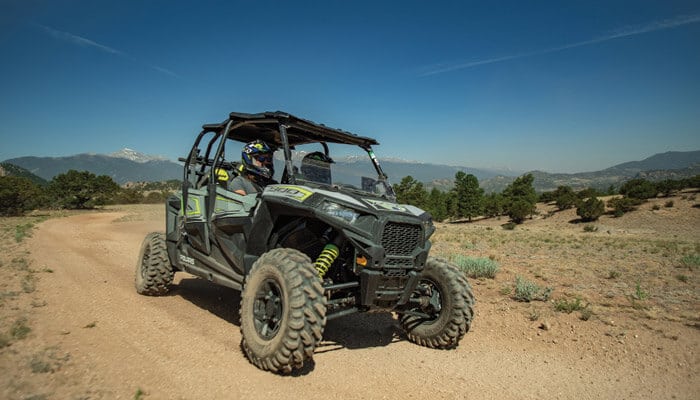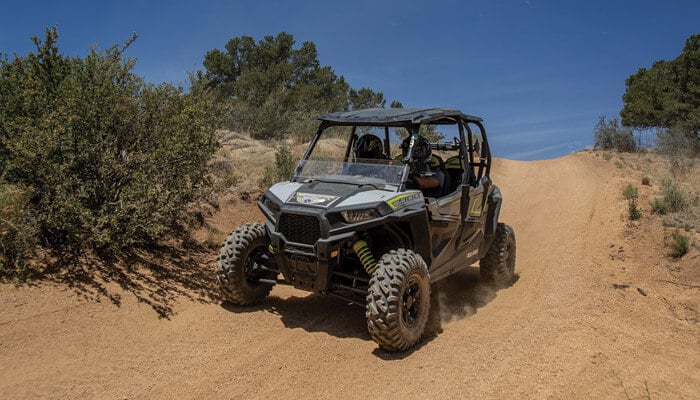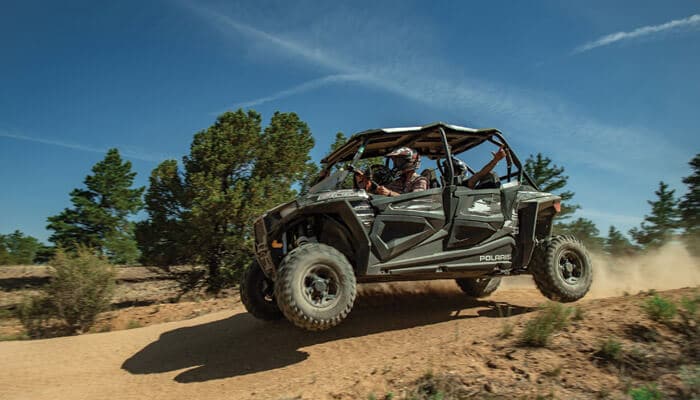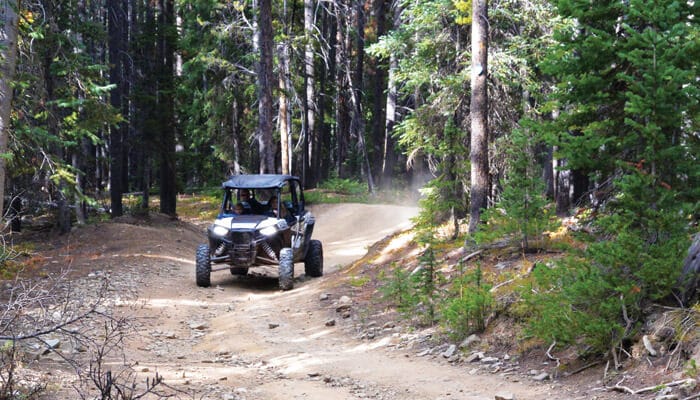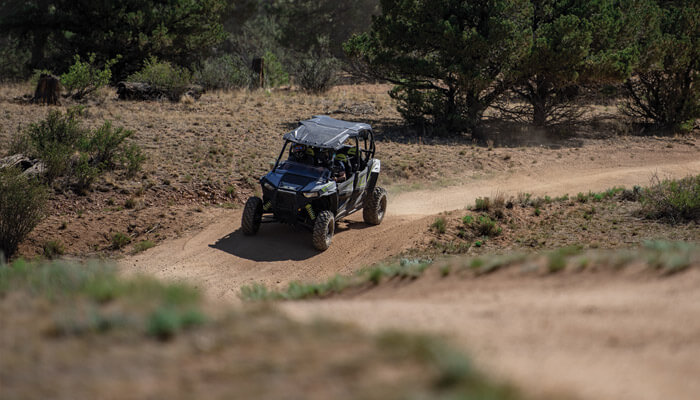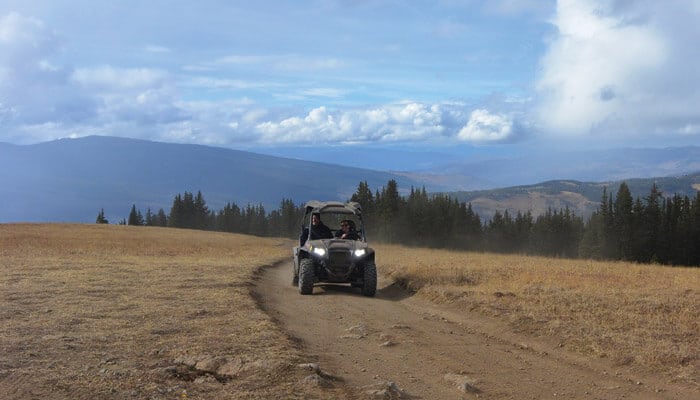ATV / RZR Side by Side Trails, OHV Trails, and Dirt Bike Trails
Be courteous to all non-motorized trail users. Respect the wildlife, livestock, and all who use the trail.
All OHV and ATV trails are in danger of being closed due to the irresponsible acts of a few. As an avid user, you can help protect our available trails for motorized use by setting a good example for all and using proper Colorado Trail Etiquette while out in the backcountry. Your behavior becomes associated with all trail riders including dirt bikers, atv riders, 4×4’s, and all other forms of motorized travel. Please do not act in such a way that will leave a black eye on the sport. A little common sense and common courtesy will go a long way in helping to protect our available lands for future motorized recreation.
COLORADO TRAIL ETIQUETTE FOR MOTORIZED VEHICLES
Colorado trails for side-by-side’s, UTVs, and ATV’s
Most side-by-side’s (RZR’s) are wider than the 50″ width allowed for standard ATV Trails in Colorado. Due to the added width, all RZR’s must remain on trails that are designated for full-size 4WD vehicles. All rules and regulations are based on the actual width of your vehicle. Just because your manual suggest that your ATV is under 50″ your aftermarket wheels and tires could place the vehicle over the 50″ threshold at which point you can no longer legally use the ATV on ATV designated trails in Colorado.
Only ride on trails that are wider than your vehicle:
A general rule to keep in mind is that if your vehicle is wider than the trail, don’t proceed forward. Only dirt bikes should be on single track trails. Trail width is often associated with both the difficulty and joy of the experience. By keeping to this rule, you help preserve the tails for long-term sustainable use and help in protecting the trails integrity for all to enjoy.
When staging, do not block the trail or the access point to the trail:
Pull off to the side of the road near the trailhead to unload and prepare your vehicle for the ride ahead. Avoid driving over parking lot barriers including rocks and other objects and be mindful of your trailers and ramps.
Encountering obstacles on the trails:
Avoid going around obstacles on the trails. Doing so will inadvertently widen the trail, cause erosion issues, and negatively impact vegetation. Stay on the trail and challenge yourself to maneuver over all obstacles while being respectful to others on the trail.
In an effort to help protect the environment, these measures should be taken when encountering similar obstacles on the trail.
1. Mud Puddles:
While maintaining a steady speed, go straight through the mud puddle while being careful to not get stuck.
2. Rocks and Scree Fields:
Go over rocks and scree fields. These are natural elements on a trail and part of the challenge.
3. Downed Trees:
If the tree is too big to climb over, go back and contact the land manager or United States Forest Service.
4. Whoopdies:
Whoops are bumps on the trails that are created from continual trail use. You should proceed to go over the whoops.
5. Switchbacks:
Do not cut the switchbacks. They help with the stability of the trail.
6. Ride Single File:
On tight trails, riding single file will help to avoid braiding and help protect against the widening of the trail.
7. Crossing Streams:
If you encounter a stream that must be crossed, do so by crossing at a 90 degree angle while staying on the trail.
8. Avoid Wetlands:
Wetlands are sensitive areas of land that have been designated as protected areas and have important significance to both wildlife and humans. Avoid wetlands and other protected areas at all cost.
Slow down and let others pass:
Slower vehicles should yield to faster moving vehicles. If you are approached on the trail by a faster moving vehicle, you should pull over and allow the faster vehicle to pass. When pulling over, choose a location that is void of sensitive vegetation and be careful to not widen the trail – find a location with added width. When a vehicle approaches, signal your intent to slow down to allow the approaching vehicle to pass.
Use caution on the descent:
Unless unique circumstances exist due to location or obstacles, the descending vehicle should always yield to the ascending (climbing) vehicles.
Passing another vehicle:
When passing another vehicle (from behind), you should always pass on the left side while keeping a safe distance and speed. Signal to the vehicle you are passing and inform their party of how many vehicles remain in your group left to pass. Two fingers indicates that you have two riders behind you and one finger means that there is only one more behind you. If you are the last rider in your group left to pass, a closed fist indicates that there are no more vehicles behind you.
Different vehicles, different approach:
Know your vehicles. Not all vehicles can maneuver the same. Dirt Bikes have minimum speed requirements while it can take some time when passing full-size jeeps and trucks. Dirt Bike and RZR operators should use caution when passing – do not “roost” while passing. Roosting is the process of gassing too quickly causing stones and debris to kick back on the windshield and face visors of the vehicle and riders being passed.
Yield to non-motorized users
Always yield the trail and be prepared to stop when passing or coming across a non-motorized user. Yield the right of way to mountain bikers, hikers, trail runners, and be especially careful when approaching horses.
Be friendly and respectful:
When encountering non-motorized trail users, be courteous and understand the importance of multi-use trails. These trails help to minimize the overall impact on the environment and help to remind us that we all have the same rights to enjoy the trails.
Be aware and be helpful:
When approaching others on the trail, always slow down and provide a healthy berth to avoid surprises. If you come across others in need, pull to the side to help. As a motorized user, you often times have the ability to call for help or to seek help much faster than others.
Always respect wildlife and livestock:
Don’t chase or harass wildlife. Always leave enough space between you and the animals. If you encounter gates on your trip, be sure to leave them as you found them – if opened, leave the gate opened. If closed, leave the gate closed.
Lastly:
Stay where you belong.
1. Remember the 50″ Rule for Side-by-Sides vs ATV’s.
2. Only drive on designated, pre-existing motorized routes.
3. Always pack a map and follow the rules of the land set forth by the United States Forest Service (USFS) and the Bureau of Land Management (BLM)
